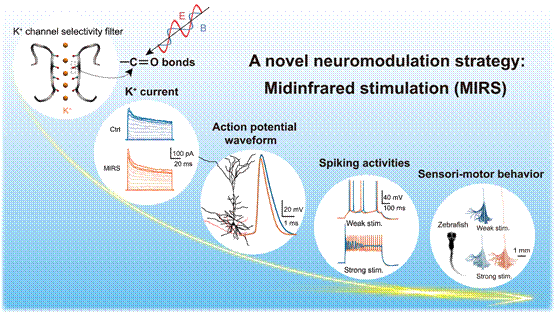Various forms of neuromodulation have been used for the regulation of brain functions and the treatment of brain disorders. Some physical approaches, such as electrical, magnetic, and optical stimulation could be employed to manipulate neural spiking activity and thus achieve neuromodulation. Optical infrared neural stimulation (INS) has been applied in studies that investigate its effects on neuronal excitability and brain functions. Most of these studies employed wavelengths within near infrared range. The underlying mechanism of INS could be attributable to the absorption of near infrared light by water and thus an increase in temperature, which would regulate neuronal excitability by the heat-induced transmembrane capacitance current or the activation of temperature-sensitive ion channels, known as the thermal effect. However, the temperature increase could be easily out of control, and overheating may cause severe tissue damage.
In a collaborative study, Prof. Yousheng Shu’s lab at the Institute for Translational Brain Research, Fudan University, chose to use midinfrared (MIR) light with relatively low absorption by water (e.g., 3.5-5.7mm in wavelength, 85.6-52.6 THz). Because the vibration frequency of chemical bonds inside biomolecules falls into the frequency range of MIR light, nonlinear resonances may occur within the biomolecules, leading to dramatic changes in their conformation and function, and thus most likely producing nonthermal effects on biological systems. Voltage-gated Na+and K+ion channels that govern the generation and conduction of action potential, the main output signal of a neuron, are such biomolecules in the nervous system. It is of interest to know whether MIR stimulation (MIRS) can cause conformational changes in these channel proteins and consequently regulate neuronal signaling.
Xi Liu, a graduate student in Prof. Shu’s lab performed patch-clamp recording from the principal pyramidal cells in mouse cerebral cortex to investigate the modulatory effects of MIRS on neuronal signaling. Xi and colleagues also performed molecular dynamics simulations to investigate the effects of MIRS on channel activities, and utilized light field imaging to examine the behavior changes in larval zebrafish.

Prior to all other experiments, Xi utilized carbon fiber with a small naked tip (7mm in diameter, 20mm in length) to map the temperature changes near the fiber tip (due to light absorption by water). Then she examined whether MIRS exerts nonthermal effects at locations outside the region with a temperature increase.
The major findings are: 1) MIRS causes resonant vibration of -C=O bonds at the ion selectivity filter of K+channels (but not that of Na+channels), and thus enhances K+permeation and K+current. 2) The augment of K+currents shortens AP waveform by accelerating its repolarization. 3) The augment of K+currents provides gain control over neuronal spiking activities, i.e., decrease spiking response to weak inputs but increase that to strong inputs. 4) MIRS modulates startle responses in larval zebrafish by sharply increasing the slope of sensorimotor input-output curve. Importantly, these effects are nonthermal, readily reversible and reproducible.
These findings indicate that MIRS represents a promising neuromodulation approach suitable for clinical application. This study also provides a new insight into the mechanism of infrared neural stimulation.
Original article:
https://doi.org/10.1073/pnas.2015685118